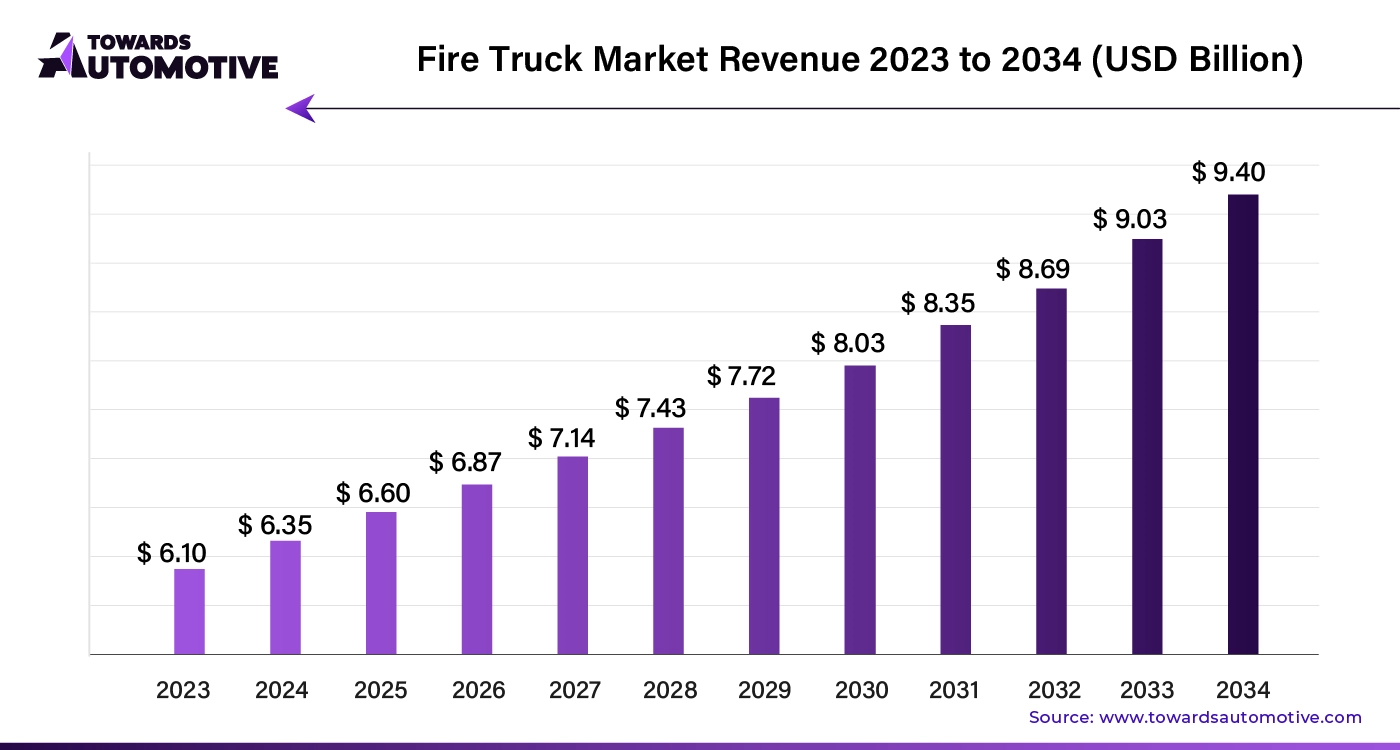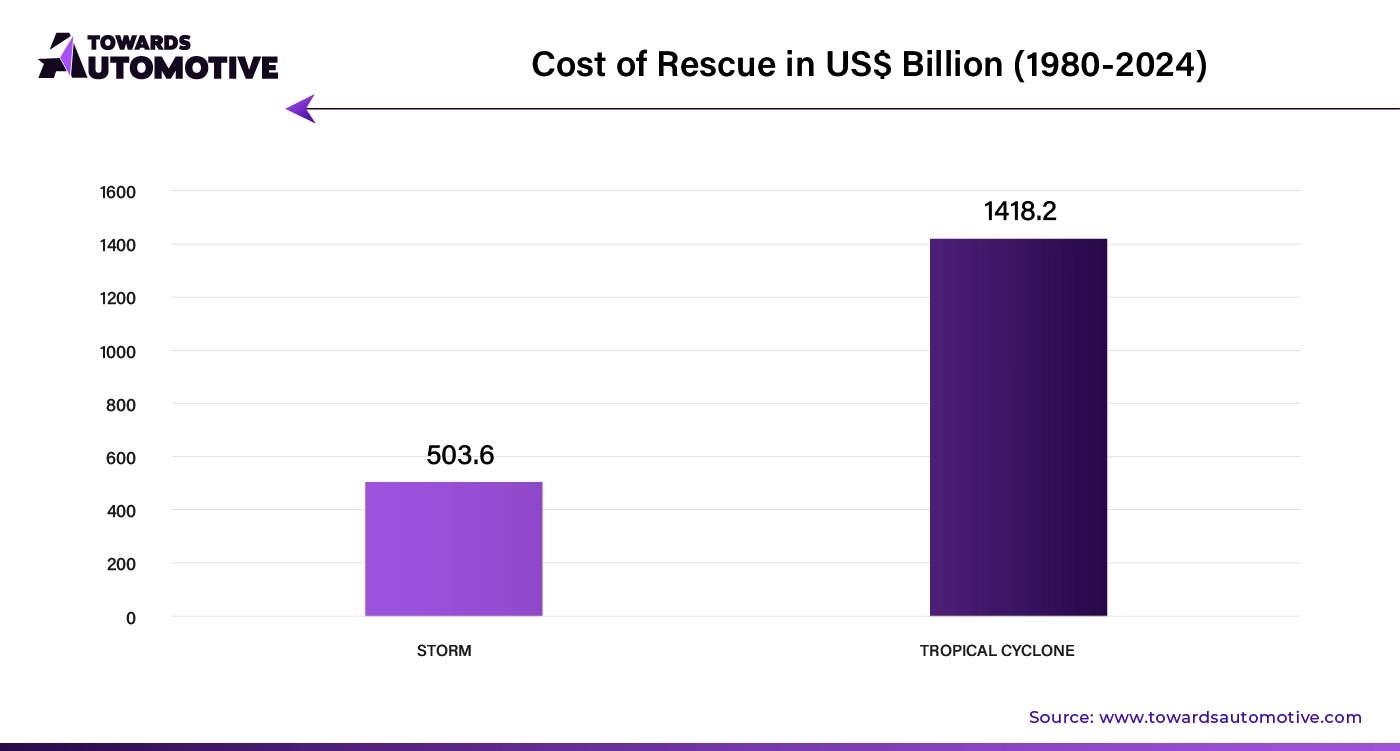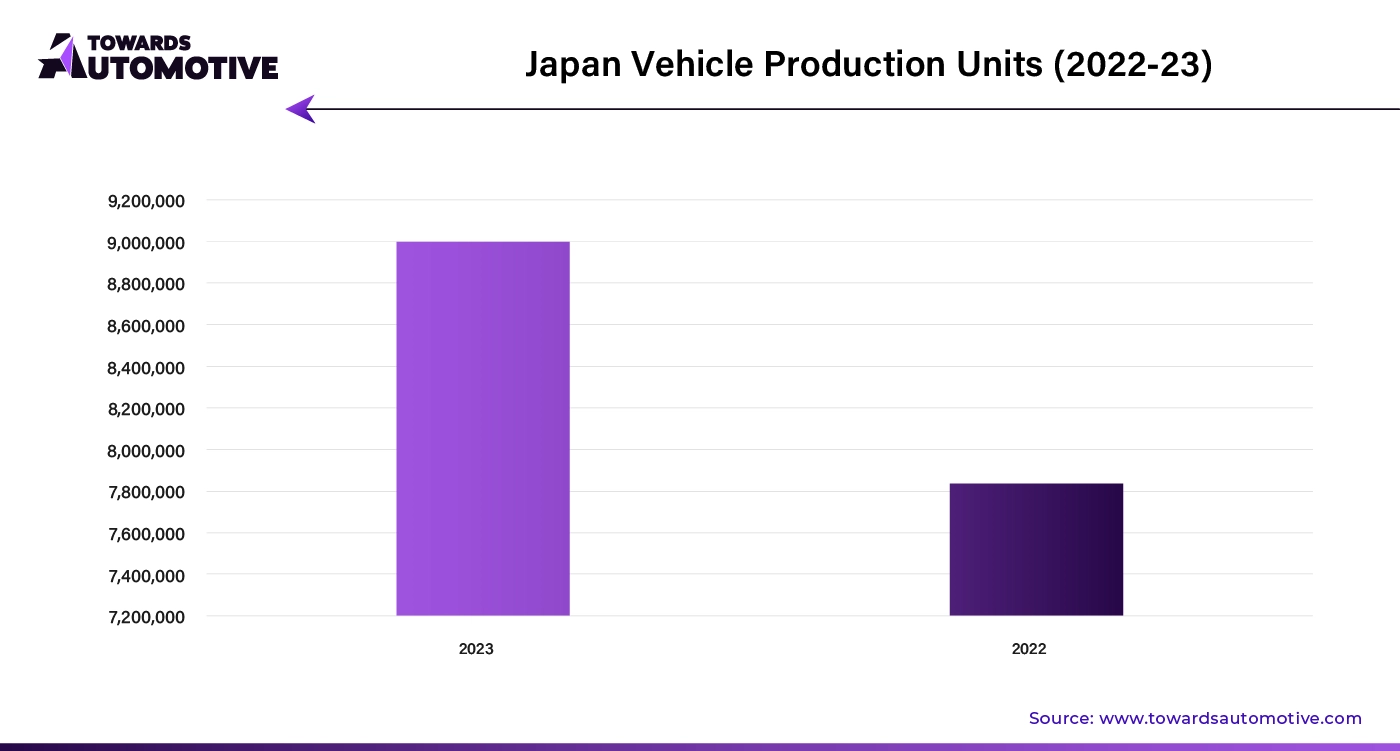April 2025

Senior Research Analyst

Reviewed By
The global fire truck market size is calculated at USD 6.35 billion in 2024 and is expected to be worth USD 9.40 billion by 2034, expanding at a CAGR of 4% from 2023 to 2034.

The fire truck market is expanding due to more frequent fires, industrial accidents, and natural disasters. Fire departments are upgrading their fleets to handle these increasing demands. They are incorporating modern technologies like telematics and artificial intelligence into their vehicles. New regulatory bodies in emerging countries are enforcing strict standards to prevent infrastructure damage and losses. Additionally, global safety standards are increasing the need for advanced firefighting equipment. The automotive market valued at USD 4,070.19 billion in 2023, is experiencing growth and is projected to surpass USD 6,678.28 billion by 2032, with a significant CAGR of over 5.66%.
Increased global emphasis on safety is driving demand for fire trucks. Developing countries are enforcing stricter regulations to prevent infrastructure damage, which is also boosting the need for fire extinguishers. Compliance with standards from organizations like the NFPA in the U.S. is a key factor.
Manufacturers are innovating to stay competitive, enhancing their fire truck offerings to meet the rising demands of firefighting and rescue operations. Rescue fire trucks and aerial platform trucks dominate the market and are expected to capture a significant share during the forecast period.
Regulatory agencies in emerging markets are implementing stringent codes and standards, which is likely to further stimulate market growth. The adoption of modern technology, including IoT and advanced digital tools, is improving fire truck efficiency and market analysis.
AI integration is revolutionizing the fire truck market by enhancing efficiency, safety, and operational capabilities. Advanced AI systems are optimizing route planning for faster emergency responses, enabling fire trucks to avoid traffic and reach incidents more swiftly. AI-powered predictive maintenance tools are identifying potential equipment failures before they occur, reducing downtime and maintenance costs. Furthermore, AI-driven data analytics are improving decision-making by providing real-time insights into fire conditions, helping firefighters strategize more effectively.
The implementation of AI also includes advanced communication systems, facilitating better coordination between fire trucks and command centers. AI-enhanced navigation systems are ensuring that fire trucks can operate effectively in complex environments, such as urban areas with heavy traffic. Additionally, AI technologies are contributing to the development of autonomous fire trucks, which could handle dangerous tasks remotely, further safeguarding firefighters' lives.
Overall, AI's integration into the fire truck market is driving significant growth by enhancing operational efficiency, reducing costs, and improving safety. As these technologies continue to evolve, they will likely bring even greater advancements to the industry.
In the fire truck market, a well-organized supply chain ensures efficiency and reliability. Manufacturers start by sourcing high-quality materials, including metal alloys and advanced electronics, from trusted suppliers. These materials are then transported to assembly plants where skilled technicians build the fire trucks according to stringent safety and performance standards.
Once assembled, fire trucks undergo rigorous testing to meet regulatory requirements and industry benchmarks. After passing inspections, they are transported to distribution centers strategically located to minimize delivery times.
At each stage, coordination between suppliers, manufacturers, and distributors is crucial. Real-time tracking systems help monitor inventory levels and manage logistics, ensuring that components arrive on time and that finished trucks reach customers without delays.
Service and maintenance parts are also part of the supply chain, supporting the long-term functionality of fire trucks. Effective communication channels between all stakeholders enable quick responses to any issues, enhancing customer satisfaction and operational reliability. By streamlining these processes, the fire truck market can deliver high-quality products efficiently and meet the critical needs of emergency services.
The fire truck market ecosystem is shaped by several key components and the contributions of various companies. Manufacturers like Rosenbauer, Pierce Manufacturing, and Magirus produce cutting-edge fire trucks, incorporating the latest technologies to enhance firefighting efficiency. These companies invest heavily in R&D to design vehicles that meet diverse operational needs, from urban to wildland firefighting.
Component suppliers play a crucial role by providing advanced materials, firefighting equipment, and safety systems. Companies like Hale Products and Darley supply essential pumps and water delivery systems, while HME Ahrens-Fox contributes specialized chassis and cab designs tailored for firefighting purposes.
Technology firms have also become vital, offering integrated solutions that improve communication, navigation, and real-time data analysis for fire departments. For instance, companies like Motorola Solutions and Honeywell provide critical communication systems and safety equipment, ensuring firefighters can operate effectively in high-risk environments.
In addition, service providers contribute through maintenance, training, and support, ensuring that fire trucks remain operational and effective throughout their lifecycle. Companies like REV Group offer comprehensive after-sales services, including maintenance and upgrades.
United States
The fire truck manufacturing industry in the U.S. is anticipated to grow at a 2.8% CAGR from 2023 to 2033. With a well-established disaster management infrastructure and a major share of the North American market, the U.S. continues to lead in fire truck sales, driven by an increase in severe fire incidents.

Germany
Germany dominated Europe’s fire truck market, holding around 32% of the market share in 2022. The industry is expected to grow at a 5.6% CAGR over the next decade. Germany’s strong automotive and engineering sectors, combined with partnerships with tech companies, are predicted to drive growth in industrial firefighting trucks.
China
China is poised to lead the Asian market with a 4.5% CAGR in fire truck supply from 2023 to 2033. The growth is being fueled by increased demands for safety infrastructure and the push for more advanced fire truck models.
Japan
Japan’s fire truck market is projected to grow at a 3.3% CAGR. The country's enhanced safety regulations and rising vehicle production position it as a significant player in the fire truck industry, especially after frequent natural disasters.

India
India’s fire truck production is forecasted to grow at a 4.4% CAGR. Government investments in advanced technology and new manufacturing facilities are supporting the market's growth, alongside a shift towards improved operational efficiency in local fire departments.
Firefighting tankers currently hold a significant market share, generating approximately 30.5% of global revenue. This trend is expected to continue as the tanker segment grows at a 2.6% CAGR from 2023 to 2033, driven by increased construction activities and stricter fire safety regulations.
Municipal fire department trucks used for residential and commercial buildings made up 56.8% of the market in 2022. This segment is projected to grow at a 3.9% CAGR, with an absolute dollar potential exceeding US$ 420 million from 2023 to 2033. Asian countries, with their large populations, are a major revenue source for this segment.
Innovations and Strategic Moves in the Fire Truck Market
The global fire truck market is highly competitive due to the presence of numerous established manufacturers and suppliers. To stay ahead, market leaders are increasingly forming strategic partnerships and expanding their operations.
By Product
By End-use Sector
By Region
April 2025
April 2025
March 2025
February 2025
Dr. Arjun Patel is a distinguished expert in the automotive industry, holding advanced degrees in Automotive Engineering and Mechanical Engineering. His expertise spans automotive market dynamics, technological advancements, and sustainable practices. Dr. Patel excels in conducting in depth research and analysis on market trends, consumer preferences, and the economic implications within the automotive sector. He is renowned for his insightful publications on topics such as electric vehicles, autonomous driving technologies, and the evolution of sustainable transportation solutions. Dr. Patels research contributions have significantly advanced understanding in the field, earning him recognition as a leading authority in automotive research and analysis.
We offer automotive expertise for market projections and customizable research, adaptable to diverse strategic approaches.
Contact Us